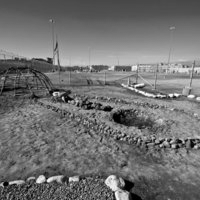Ojibwe
The Ojibwe are one of two contemporary peoples indigenous to the lands that became Minnesota, the other being the Dakota. Ojibwe oral history tells that their migration from the Atlantic coast to Minnesota was prophesied in 900 C.E. when seven prophets emerged from the ocean. One said that the Ojibwe must move west or perish, and that they would know they had reached their destination when they found food that grew on water, referring to manoomin, or wild rice, their traditional staple and sacred food. The other prophets foresaw conflict with European settlers and times of great loss, the loss of their lands, children, language, spirituality, and culture. The final prophet said that after all this suffering would come a period of revival and healing, which characterizes the present. The story reminds Ojibwe of their purpose, history, struggles, and triumphs, and of the importance of environmental stewardship and their spirituality.
Supernatural forces and the transcendent entity called gichi-manidoo, translated as 'great spirit' or 'great mystery' are important in Ojibwe religion. Gichi-manidoo has come, in some ways, to overlap with the concept of God after centuries of Christian contact. The Midewiwin, or Grand Medicine Society, composed of spiritual leaders and healers, is another significant aspect of the Ojibwe religion and worldview. The members lead religious ceremonies, study sacred occult healing methods, and maintain a positive relationship with the planet. The Midewiwin lodge is a vital spiritual center for prayer, education, rites of passage, and gathering. Although it is less prevalent today than in the past, the Midewiwin has served as a fortress of faith, withstanding restrictions and assimilation to preserve fundamental aspects of Ojibwe spirituality for present generations.
The Ojibwe arrived at Madeline Island on Lake Superior in 1395 and participated in the fur trade when the French arrived in the 1600s. They were also the first to harvest maple syrup. Like the Dakota in southern Minnesota, many places of significance to the Ojibwe in northern Minnesota bear traditional names, and the Ojibwe also contributed words such as moose, toboggan, and moccasin to English. Traditional homelands in the north are known as Anishinaabe Akiing, translated either as "the people of the land" or "the land of the people" and reflecting a worldview that inverts typical notions of cause and effect. Instead of asking simply, "How do the people influence the land?" a more significant question is, "How does the land influence the people?" Ojibwe spirituality places great importance on the land, water, and air. The waters of Minnesota are very significant as providers of transportation, drinking water, and food. Traditionally, the Dakota lived in harmony with natural cycles, structuring their lives in accordance with the seasons and holding great respect for life.
An influx of white settlers in the 19th century led to a series of treaties that ceded traditional Ojibwe homelands to the U.S. in exchange for payments that were rarely given and deeply affected Ojibwe lifestyles and their connections to land. Christian missions and forcible English-only boarding schools, the latter of which were deliberate attempts to sever indigenous children's connections to kinship, land, culture, language, and religion, led to the losses that many of the prophets anticipated. Protestant missionaries sought to root out Dakota and Ojibwe values with hymns translated into their respective languages, but within the limits of Christianization, the Ojibwe made this singing their own ritual, a practice that continues today at funeral wakes. Between 1883 and 1934, reservation life was governed by administrative laws known as the Civilization Regulations, sometimes called the Religious Crimes Code, under which Dakota and Ojibwe peoples could be jailed and fined for participating in the Sun Dance, funerary give-away feasts, and traditional medicine and healing ceremonies.
In 1968, the American Indian Movement (AIM) was formed in Minneapolis by two Ojibwe leaders; the AIM grew its presence and scope to reconnect Dakota and other native peoples with their language, spirituality, and kin, which led to national legislation in the areas of education, self-determination, religious freedom, and language. Particularly important was the AIM's emphasis on spirituality, which would help native peoples combat the causes of their suffering. In 1999, the U.S. Supreme Court upheld the Ojibwe rights to hunt, fish, and gather in the lands that they had ceded in the 1837 Pine Treaty. Today, many Ojibwe live on one of seven reservations that were created in the mid-19th century at Fond du Lac, Grand Portage, Leech Lake, Mille Lacs, Red Lake, Boise Forte, and White Earth. Whether they live on one of these reservations, in outlying states, or in Canada, Ojibwe continue to live in profound relationship to homelands and sacred places both on and beyond reservation boundaries despite centuries of conflict and hardship. Their endurance recalls the oral history of the seven prophecies and speaks to the strength of a culture, a language, a spirituality, and a people that refused to be extinguished.
Unpublished Exhibits
Pictographs in the BWCA

The Boundary Waters Canoe Area Wilderness is a protected area of over 800,000 acres in Northern Minnesota. Prior to a...
Wolves and Anishinaabeg in Minnesota

This exhibit explores the convergence of different opinions regarding how best to "manage" wolves as a natural resource, particularly emphasizing...
Eagle Feather Protection

Lake Superior as a Cultural Resource

An overview of the cultural significance of Lake Superior and the importance of sites on its shores to the Ojibwe...
Ojibwe Language Revitalization

An overview and history of the Ojibwe people's struggle to maintain cultural identity and their current push towards revitalization of...
NAGPRA in Minnesota

This exhibit attempts to shed some light on why The Native American Graves and Repatriation Act is still needed today...
Eagle Rock Mining Controversy

The controversy over Eagle Mine, a nickle and copper sulfide mine located in Michigan's upper peninsula, and Eagle rock, an...
Ojibwe Spirituality and Water

A look at Ojibwe spirituality and how it impacts relationships to water in the land of 10,000 lakes
Ojibwe Traditional Cultural Properties in the Boundary Waters

Minnesotans view the Boundary Waters Canoe Area Wilderness (B.W.C.A.W.) as everybody's resource -- a wilderness largely untouched by human activity. ...
Native American Religious Freedom at Stillwater Correctional Facility, MN

Listen to Minnesota Religions

